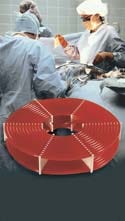April 1, 2003
Originally Published MPMN April 2003
INDUSTRY NEWS
Polyvinyl Chloride Compound Prevents Blood Clotting
Zachary Turke
|
This heat exchanger is produced from a Vestolit compound developed by Teknor Apex to prevent blood clotting during critical procedures. |
A new polyvinyl chloride compound from Teknor Apex (Anaheim, CA; www.teknor-apex.com)prevents blood clotting by incorporating special molecules that trick the cells into thinking they're in the presence of heparin, the body's natural coagulant. "In the past, manufacturers have tried to deal with coagulation by coating a device with heparin or a heparin-like substance," says medical manager PeterGalland. "But coatings are expensive and nonpermanent. What makes our material exciting is that it is the first product that incorporates anticoagulation properties directly into the material structure itself, so it can't be removed or extracted," he says.
To take advantage of this unique property, manufacturers will not need to construct a device solely of the patented PVC. Instead, Teknor Apex recommends that they coextrude a thin layer of the bioactive polymer on the inside wall surface of the device. "This specialized compound costs more than standard medical-grade vinyl," says Galland. "By limiting it to a thin inner layer, the overall material cost will rise by less than the added cost of most current coating methods."
Having acquired the rights to distribute the material from Vestolit (Marn, Germany;www.vestolit.com), Teknor Apex hopes to commercialize the product within two years. After the material receives FDA approval, it could find use in wound-drainage, catheter, cardiopulmonary-bypass, hemo-dialysis, hemofiltration, dialysis, and blood-collection and -storage applications. But Galland hints that more uses may just be on the horizon.
"There is some preliminary evidence that the material may also exhibit bacteriophobic and bacteriostatic properties that would give it additional applications, but we need to research these attributes more thoroughly," he says.
Copyright ©2003 Medical Product Manufacturing News
You May Also Like



